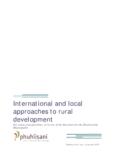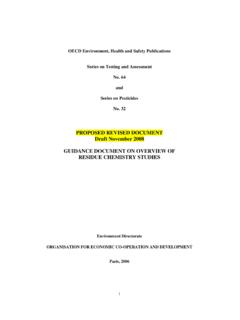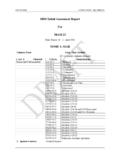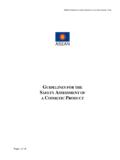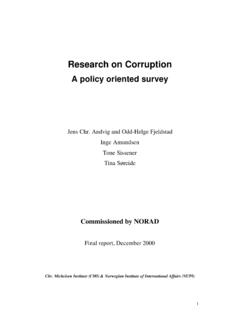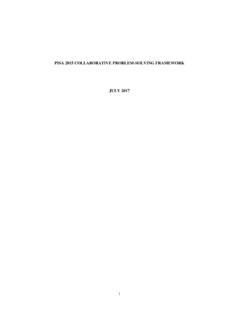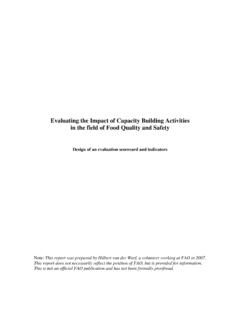Transcription of Extension and small holder agriculture - …
1 Extension and small holder agriculture Key issues from a review of the tlitera ure First draft : 16th June 2008 Sustainable Development Specialists Boyce Williams David Mayson Rick de Satg Shelley Epstein Thembinkosi Semwayo isiXhosa: uphuhliso, n. Development; ukuphuhlisa, v. to explain something making it outstandingly clear. Contents Background to the research enquiry .. 3 Improving support to smallholders .. 3 Key questions .. 4 Focusing on Extension .. 4 A short history of Extension and farmer support in South Africa .. 5 Historical measures to strengthen the white commercial farming sector.
2 5 Historical measures to regulate production and land use in the Reserves and the homelands .. 6 The homeland era .. 6 The transition .. 8 New agricultural policy .. 9 Rethinking the two agricultures thesis .. 10 The need for a new 11 Training Extension staff .. 12 Assessing Extension effectiveness .. 13 Developing an appropriate Extension approach .. 14 Norms and standards for agricultural Extension and advisory services .. 14 The state of the Extension service .. 15 Extension job differentiation .. 15 Extension staff employed per province .. 15 Qualification assessment.
3 16 Gender and qualification .. 16 In service training .. 16 Extension demographics .. 17 Projected Extension : farmer ratios .. 17 The Extension recovery plan .. 17 Extension support to land reform .. 18 Urban areas .. 19 Former Homeland and Act 9 areas .. 20 Eastern Cape .. 20 Free State .. 20 Kwazulu-Natal .. 20 Limpopo .. 21 Mpumalanga .. 21 North West .. 21 Western Cape .. 22 Northern 22 International Extension approaches .. 22 Key issues and conclusions .. 25 References .. 26 Background to the research enquiry The Office of the President is devising a suite of second economy strategies to complement a sweeping government-led anti-poverty strategy.
4 One of the opportunities that have been identified is the agricultural sector, in particular the fostering of a larger number of smallholder agriculturalists. Land reform provides opportunities to address one of the constraints on smallholder production access to productive land but to date has not done so, in part because of inappropriate planning and delivery processes and inadequate post-settlement support. The purpose of the research and strategy development project led by the Programme for Land and Agrarian Studies (PLAAS) in co-operation with several other institutions is to help identify the key elements of an implementable programme to support the smallholder sector.
5 The research component focuses on identifying successful South African smallholders active in different settings, and examines the personal, contextual and institutional factors that contribute to their success. Improving support to smallholders Clearly for support measures to be effectively targeted there needs to be some consensus on how to characterise smallholder agricultural producers and identify the different settings in which they can be found. There are no immediate definitions in common usage in South Africa. Elsewhere in the region definitions relate to the amount of land cultivated by the farmer.
6 In Zambia small holder farmers are defined as those marginal and sub marginal farm households that own or/and cultivate less than hectare of land. (Chipokolo, 2006). However in South Africa smallholders can be found in urban and peri-urban settings, on municipal commonage and in rural areas including the former homelands. Over the years there have been a number of initiatives, many co-oercive, few genuinely supportive to strengthen the smallholder sector. The design of support measures tends to veer between two extremes: The temptation to identify the single constraint that must be addressed in order for smallholders to flourish and thrive, land or credit, which result in a search for silver bullet policy interventions.
7 The supposition that any programme aiming to support smallholders must be holistic , by which is usually meant that it must provide all types of support simultaneously on the premise that the absence of any one of them will lead to the programme s failure. (Programme for Land and Agrarian Studies, 2008) Historically there was often an implicit supposition that support for smallholder agriculturalists would enable them to derive their core livelihood from agricultural production and make the transition to fulltime farming.
8 However in most cases household agricultural activities represent just one, (often small ) element within a more diversified set of household livelihood strategies an 3 element which as it increases in scale may carry a correspondingly higher level of economic and social risk for the smallholder. The design of an implementable programme to support smallholder agriculture has to steer between analysis that prioritises single constraints which usually results in interventions that are inadequate, and the development of ambitious integrated and holistic solutions which may be unaffordable or which can serve very few people.
9 (Programme for Land and Agrarian Studies, 2008) Hence our focus is on identifying core factors, which if addressed can create a more enabling environment for more productive and innovative smallholder agriculture located within a broader context of improved household livelihood security and reduced vulnerability and risk. Key questions Clearly the overarching research question must address the contribution that the support of smallholder agriculture can make to poverty reduction. Although there is a widespread call for increasing investment in small holder agriculture as a pathway out of poverty there is debate as to how effective this will be.
10 A 2006 OECD review argued that it is clear that the potential of agriculture and agricultural (land) reform itself to reduce poverty is limited. The long-term solution to poverty reduction requires involving a greater part of the rural poor in economic activities generating sufficient income. The main potential to reduce rural poverty and inequity lies in the development of overall frameworks providing social security, education and training as well as health care, and in developing adequate infrastructures in rural areas (Organisation for Economic Co-operation and Development, 2006) However DFID has argued that at the macro-economic level, growth in agriculture has been consistently shown to be more beneficial to the poor than growth in other sectors.
